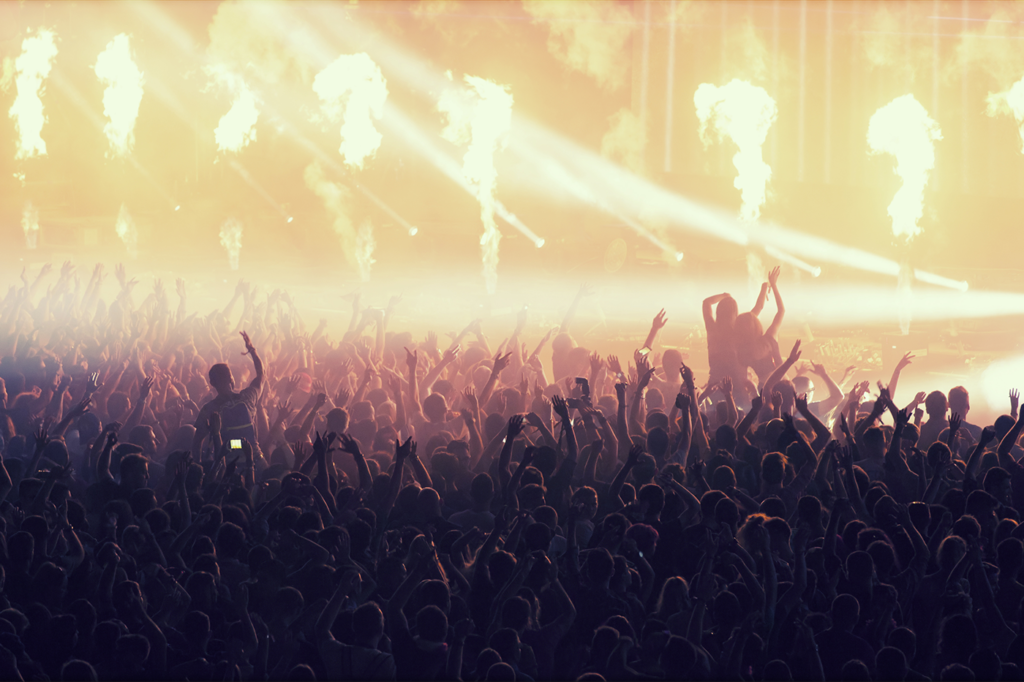Understanding the 1960s—that intense, immense thing in American life that ended exactly fifty years ago—is a difficult task if ever there was one. The work is made all the more difficult by the fact that, as Peter Collier has observed, many of those who spent the ’60s trying to burn down the universities subsequently applied to graduate school in order to “spread the ideas that had been discredited in the streets under an academic cover.” The narrative of the 1960s that emerges from the pens of too many well-trained PhDs is yawningly predictable: good, good radicals challenge the bad, bad traditional order created and maintained by bad, bad conservatives, and the struggle continues hasta la victoria siempre!
Understanding the 1960s—that intense, immense thing in American life that ended exactly fifty years ago—is a difficult task if ever there was one.
Yet once one escapes the leaden narratives of the unapologetic ideologues, one finds that what can be said about 1969 alone could fill volumes. All years in the life of a modern nation are complicated affairs; but this one was especially so, given all that was afoot in American society and international affairs at the time: a Cold War stretching from the heat of the war in Vietnam to the cold climes of the moon, and a domestic political and cultural struggle inside the US to match the ferocity and passion of that international struggle.
How can one hope to put any easily digestible shape to that?
Start your day with Public Discourse
Sign up and get our daily essays sent straight to your inbox.In 100 Days: How Four Events in 1969 Shaped America, Harlan Lebo uses a convenient mechanism for such a meaning-making project. He cuts the historical object “1969” into just four events. The selection of events—the Apollo 11 moon landing, the Charles Manson murders, Woodstock, and the invention of Arpanet, the prototype for what would eventually become the Internet—is, of course, not objective. Lebo is not a straightforward radical apologist for ’60s excess. Nonetheless, he clearly wants his map to make the case that 1969—like the ’60s as a whole—is essentially something to be celebrated, with just a smattering of excess and regret.
But how well does that narrative hold up?
Recalling the Full Truth of the Countercultural Spirits of ’69
Lebo’s discussion of Woodstock exhibits the same facile cheerleading too commonly encountered on this topic. It echoes the sentiment of Max Yasgur, the owner of the farm in Bethel, New York where the festival took place, captured in the lengthy film on the festival. America, Yasgur tells us, is about giving us the freedom to be like the hippie kids at the festival.
We are almost never reminded that Woodstock produced things quite more troubling than the joyful abandon of the dancing, naked hippies. It also had as a consequence two deaths from drug overdose in three days, in a population of 400,000 people. In addition to the deaths, more than 800 people at the festival were treated for drug-related medical emergencies, as reported by the New York State Department of Health. Extrapolated out to a full year, the Woodstock fatal drug overdose rate is three times higher than the current American rate, and the rate of drug-related medical treatment equates to roughly one in four people.
Just a few days before Woodstock, the Manson murders were taking place on the other side of the country in California. Lebo’s consideration of this dreadful piece of 1969 is admirable, emphasizing some of the broader connections of Manson’s insanity to the ’60s musical counterculture. Still, he fails to connect as fully as he might all the sinister dots linking Manson, the deeds of his “Family,” and the rest of the counterculture he inhabited.
In a December 1968 interview with the title “I Live With 17 Girls,” the Beach Boys’ Dennis Wilson described his relationship with a number of Manson’s female cult members—“space ladies,” in his terms—whom he was thinking of launching in a musical career. Through them, he met their “guru, a guy named Charlie who’d recently come out of jail after twelve years.” Manson, Wilson went on, had “drifted into crime, but when I met him, I found he had great musical ideas. We’re writing together now. He’s dumb, in some ways, but I accept his approach and have learnt from him.” Wilson let members of the Manson Family live in his Sunset Boulevard home, and he introduced Manson to Terry Melcher, the music producer son of Doris Day. Manson later dropped by Melcher’s home unannounced, but Melcher had moved. The new resident was Sharon Tate, who turned him away. Manson did not forget this spurning.
Charles Manson did not become a famous musician, and his failure in the music industry motivated some of his monstrous rage. A Beach Boys’ song, “Never Learn Not to Love,” was a rewritten version of a Manson composition titled “Cease to Exist,” and the lack of a songwriting credit greatly angered him. When the Beatles’ White Album was released in November 1968, Manson heard it as a call to violent social revolution through assassination, murder, and race war.
It is too easy now, especially given a certain political predilection, to see this as a wholly distinctive and idiosyncratic reading of the cultural temperature of the moment. The truth is that this is reasonably summarized as a central component of the spirit of the times. Manson’s worldview, and the demonic deeds of his cult, were cheered and embraced by others who had a much longer and more thorough effect on American culture and politics. As a cultural figure and icon, Manson resonated with the most extreme elements of the young radical political movement, which were ascendant at the end of the ’60s. At the June 1969 national convention of the Students for a Democratic Society (SDS), a splinter group calling itself the Revolutionary Youth Movement, with the support of the Black Panther Party, forced the dissolution of SDS. The Revolutionary Youth Movement went on to splinter still further, and a highly radicalized faction within it became the terrorist Weather Underground.
In October 1969, the young revolutionaries in the Weather Underground led a group of a few hundred crazed young people on a rampage through Chicago’s Gold Coast. Wearing helmets and carrying clubs and baseball bats, they fought pitched battles with police, smashed storefront windows, and destroyed parked automobiles. The police made short work of them, but the message was clear: radical youth had now stepped completely outside the moral boundaries of the American political landscape into a world of pure violent destruction and mayhem. High-ranking members of the Weathermen made expressions of support for bombings and even assassination legitimate political tactics against “Amerika,” as they sneeringly referred to it. Eventually, they would build their own bombs.
Bernardine Dohrn, one of the leading figures in the Weathermen, spoke about the Manson murders at a December 1969 “Wargasm” council of the group in the following terms: “The Weathermen dig Charlie Manson. . . . Imagine, they stuck a fork in them—Wild!” The fork emblem briefly became a symbol of Weatherman extremity. Dohrn and others called for the murder of white American babies as a political act. At the conclusion of the radical council, members of the Weather Underground retired to the nave of a nearby Catholic church for group orgies.
What became of these celebrities of the violent counterculture who so openly celebrated the mass murder by Charles Manson and his insane group? Dohrn is now an emerita faculty member of the Northwestern University Law School. Her husband Bill Ayers, a fellow member of the Weather Underground who enthusiastically participated in some of the group’s bombing attacks, is an emeritus faculty member of the University of Illinois. They spent the decades after their expression of embrace of the values of Charles Manson teaching young people in elite institutions and being paid handsomely for it.
Long into his life sentence, Charles Manson was still courted by musicians in the mainstream industry who were eager to aid him in recording and disseminating his music. Henry Rollins tried to arrange the recording of some of his songs on the punk label SST, when he was a member of Black Flag, but “a string of death threats” forced the calling off of the project. Rollins later admitted that “having [Manson] write me letters made me feel intense and heavy.” Guns ’n’ Roses, Marilyn Manson, and the Brian Jonestown Massacre, among other well-known musicians, have covered Manson songs.
1969 in Sum: Remembering Altamont
An event that arguably sums 1969—and perhaps the entirety of the ’60s—more thoroughly than any of those Lebo discusses, somehow escapes discussion in his book. The Rolling Stones’ Altamont concert of December 6, 1969 is a near-perfect symbol of the disturbing legacy of 1969 and the ’60s counterculture.
This unruly entity ‘the ’60s’ cannot be reduced to the preferred progressive narrative, i.e., necessary and broadly positive social and cultural change that freed restrained populations from the grip of crushing and soul-destroying traditional culture and belief. But, if one is rigorously honest, neither can the ’60s be legitimately turned into the too simple contrary story from the right: a horrifying, monstrous, and obviously evil annihilation of the good and the true. To be sure, the good was under attack at Altamont, and in the counterculture. But this was done with stealth, under the concealment of what appears, to the superficial eye, to be beauty.
This is the way of devils and demons. To be too overt in hideousness and horror is to risk preparing the would-be victim in advance for the assault. Better to dissemble, to hide at least occasionally behind masks. This eases entry to an unguarded hearth and thereby assures the desired violation.
By the time the Rolling Stones took the stage at the old Altamont Speedway on December 6, 1969, they already had a reputation in the pop culture world of the era as bad boys, even as emissaries of evil, in the half-serious way in which such things are intended in the analysis of people who make careers writing about rock stars. Rock ’n’ roll should never be respectable, Eric Clapton said somewhere, probably copying what some bluesman said about the blues, and the Stones had made that their motto. Founding member Brian Jones had been sacked in the summer of 1969 because of his drug excesses, and he promptly died after a month of a drug-related misadventure. The remaining Stones continued along the transgressive route, undaunted by the demise of their comrade. These were audacious, unapologetic young men, and they entertained a fantasy of themselves as strutting, reckless rebels. A collection of shaggy-haired, drug-addicted young men with guitars, however, requires some external help to produce real danger, and Mick Jagger and his brethren got that assistance from the spirit of the counterculture in that late fall of 1969.
There is no denying, when one views the cinematic record of that concert, the film Gimme Shelter, that there was something akin to beauty in some of the Stones’ music of this period, and something still closer to it in their faces and in the faces of some of those who followed them around as they sang their songs. Readers who have not seen it should do so if they want to fully understand how the evil of cultural nihilism and anarchy presents itself.
The film is by turns gut-wrenchingly terrifying and astonishingly seductive. It is the faux angelic smiles and the comely silhouettes of the girls in the front row, searching for a second’s attention from Jagger, these obsequious nymphs, fawning children already wholly and perversely sexualized in the way that has become de rigueur in American culture 2019. It is also the spastically gyrating, intoxicated boy who has somehow managed to get himself atop a scaffold stories above the crowd, and who teeters precariously close to toppling to his death; and the vacant, inhuman stare of the naked obese woman in the front row, attempting to climb over and through her fellow audience members as though they were inanimate objects. It is the fat, sweet electric guitar chords and the swaying, frantic drumbeats from the stage; and it is the sinister glares, and snarled insults, and lobbed beer bottles, and flashing pool cues of the bearded and leering Hell’s Angels. It is Mick Jagger’s impish grin as he voluptuously takes in the crowd as he climbs on to the stage; and it is the slender pistol produced by Meredith Hunter and aimed at that same impish singer and then the knife blade that glides almost unseen across the screen to snuff out Hunter’s life. It is the naïve hippie promise of a wonderful day of utopian peace with no restrictions or plans required—“it’s all gonna be an experiment,” as one of the show’s non-organizers puts it; and it is the inevitable, predictable, and dreadful outcome of a few hundred thousand human beings together in one place, with no moral rules, no authority to enforce such rules even if they were present, plentiful intoxicants and hallucinogenic agents, and turbulent, unpredictable, yet absolutely deterministic human nature in abundance.
The film does not even show us the full extent of the depravity. It is only hinted at in the commentary track, in which we are told by the directors that the Hell’s Angels and many others in the crowd stayed on long after the show. The Angels built a huge bonfire out of scrap wood, and the remaining hippies were “drawn like moths to the fire.” And thus “the beatings and the battery continued on at length into the night.”
This is how the evil of cultural destruction presents itself. It would be so easy to turn aside from it, if all collapsed into ugly, nauseating chaos instantly as soon as the old cultural rules and restrictions were abandoned. Such things take a little bit of time, though, to materialize in their full wreckage, and they can produce beguiling little temptations in the forms of pleasant sounds, and intoxicating substances, and seductive human forms all along the way. Why was there such a consuming desire to “experiment,” to reject planning, to put into action stupendously poor organizational decisions in the most cavalier, irresponsible way imaginable, given the possibility of catastrophic consequences? Because, the counterculturalists maintained, “the system is corrupt.” Because, they reasoned, things could not conceivably be worse. Why not experiment? What is there to lose? Only everything, if it turns out—as it did—that things could be worse.
It is just at the end of a song titled “Under My Thumb” that Hunter is killed, as he is pointing his gun at the stage. In the film, Jagger does not seem fully to realize that, had the Hell’s Angels not murdered Hunter, Hunter might well have murdered him or one of his bandmates. The song is about sexual domination of a woman by a man, purportedly a reflection of a dysfunctional relationship Jagger was in at the time it was written. In another song that the Stones play just before the fatal crescendo, “Sympathy for the Devil,” Jagger croons “Every cop is a criminal, and all the sinners saints.” Did he know that the traditional Judeo-Christian cultural world he and his fellows rejected accepted precisely this moral complexity? Yes, it assures us, all are sinners, even the saints, and none wholly escape the temptation of evil.
The difference between the culture of Altamont and the culture it wanted to supersede is both subtle and immense. Recognizing the unavoidable contagion of evil, the pre-’60s American cultural world endeavored to maintain time-honored methods and structures that had kept it at bay sufficiently to enable the human drama of moral progress. By contrast, in the stupefied debauchery and irresponsibility of the hippie counterculture, the sinners and the criminals are not just recognized as unavoidably and eternally among us. They are presented as the only models to emulate. If all are impure, after all, it is much better to be a killer than a priest. Only the former can conceivably be cool—and what else is there to be pursued?
A month before Altamont, on November 3, President Nixon delivered the speech in which he referred to the great silent majority who opposed this demonic threat from the radical fringe. By the mid-1980s, in the midst of two Reagan administrations and the rise of the Moral Majority, the American right was convinced that this silent majority had won the day.
They were too confident. Fifty years after Altamont, no clear-eyed observer of American culture can doubt that the demonic spirit of 1969 is still very much in the air in our country.












